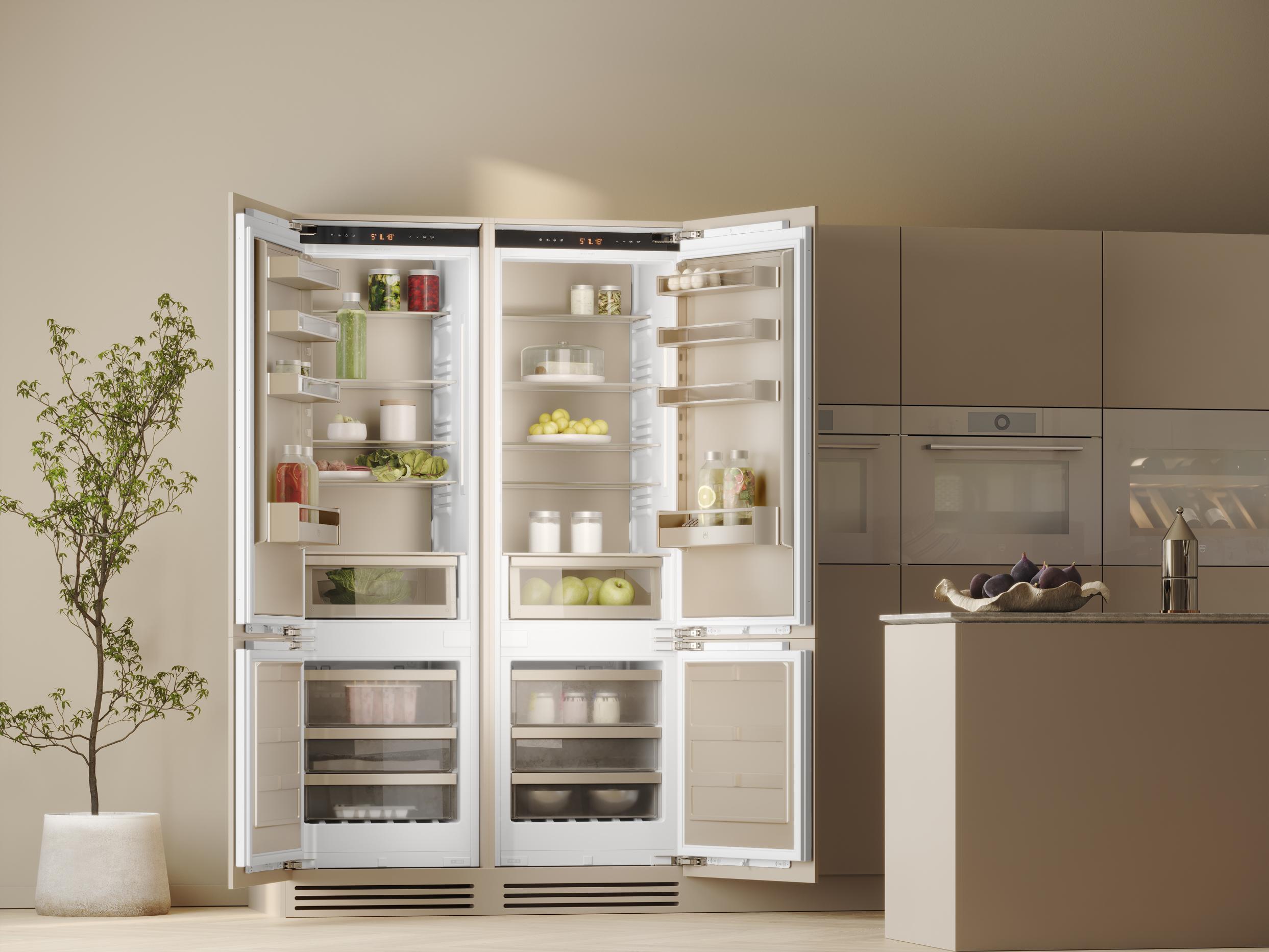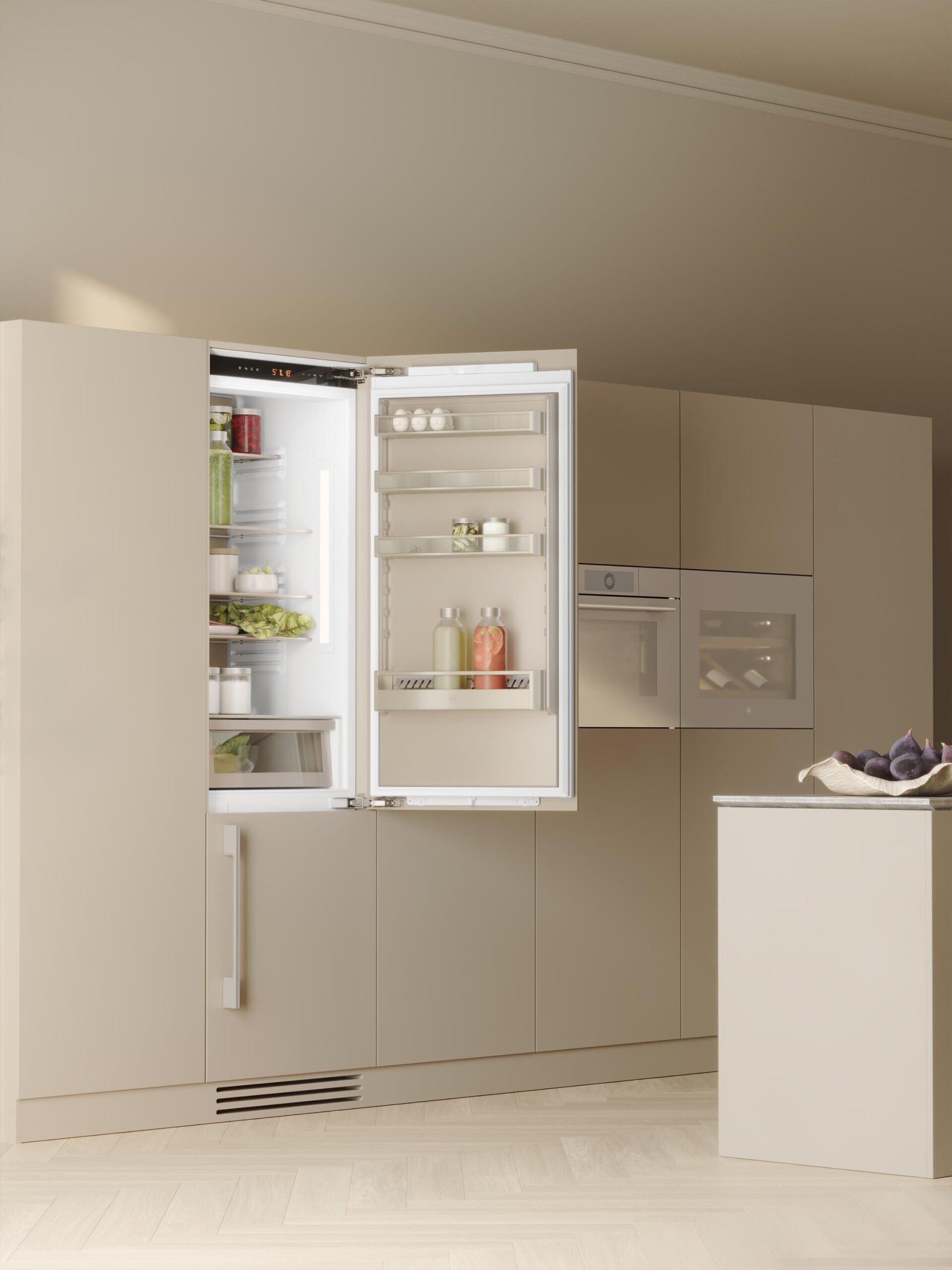“A lot of innovation in the cooling appliances space has been focused on reducing energy consumption,” Alberto Bertoz, V-ZUG’s Chief International Officer, explains. “And rightly so. Much of it has been driven by the need to comply with energy regulations, which made sense over the last decade, as we saw a big drop in energy consumption.”
But now, he suggests, the industry has reached a point where, to achieve a minimal reduction in energy use, it’s sometimes forced to rely on solutions that are more harmful to the environment than the energy they help save. Alberto points to VIPs – vacuum-insulated panels – as a prime example. “They have outstanding insulating properties, but they’re not very environmentally friendly,” he says.

V-ZUG’s CIO adds that single-mindedly pursuing these incremental, ever-smaller energy savings can be at odds with enhancing the user experience, which he personally considers the heart of meaningful innovation. “Beyond energy, our focus is squarely on the consumer,” he says, echoing the notion that cooling, above anything else, is a lifelong and indispensable companion in our daily lives. “We always consider how they use their fridges and freezers, and what we can add to enhance that experience.”
This dual ethos – mastering technical performance while pioneering a more human-centric vision – finds a fitting expression in V-ZUG’s flagship cooling appliances. The signature CombiCooler V6000 178NI, a Swiss-designed integrated two door fridge and freezer combination. The appliance is equipped with PureCool technology, which enables it to achieve the 6-star Energy Rating Label, making it one of the most energy-efficient models on the market. At the same time, its reimagined interior is a compelling preamble to an intricate array of user-centric design gestures that define V-ZUG’s holistic offering. Its warm, sophisticated palette, delineated by the soft elegance of the pearl-coloured shelf trim and a new LED lighting concept, reframes the pragmatism of food preservation as culinary inspiration for the user at the core of the cooling experience.

That same human-centric ethos is also exemplified in the interconnectedness V-ZUG fosters through its Italian-manufactured range, represented by the CombiCooler V6000 75 Supreme. “In our Supreme line, the evaporators are on the side, not the back, which makes the interior deeper,” Alberto explains. “This has allowed us to design our refrigerator shelves to perfectly fit a full-sized oven tray.” And while this kind of quiet enhancement might not seem hugely innovative, it makes the day-to-day that much more convenient. “You can prepare food on a tray, keep it refrigerated and then transfer it directly into the oven. It might be a small thing, but it’s brilliant,” Alberto smiles.
It’s these carefully considered, and at times deceptively humble, design interventions that define both the CombiCooler V6000 178NI and its Italian-made Supreme counterpart. The appliances feature the unique InfinityShelf system, which allows users to adjust the shelves with incredible ease and precision. “You can move them by just a few millimetres to fit whatever you need, from a champagne bottle to a large dish,” Alberto describes. This fusion of rigorous control and effortless adaptability is also evident in the MonoFridge function, which allows the user to convert the freezer compartment into an additional cooling zone with a single touch of a button.
These are the kinds of details that, while not as explicitly or immediately apparent, make all the difference, and this attentive focus on the user encompasses both the composition and size of the appliances. Alberto points to the CombiCooler V6000 75 Supreme as an example. While the model features the same advanced cooling technology and premium interior feel as the bigger 90cm option, its compact footprint reveals an additional layer of delightful flexibility and unexpected dimension.

“Its streamlined and efficient size makes it perfect for smaller-scale spaces,” Alberto enthuses. “But, in bigger kitchens, you can place two 75cm units side-by-side to create an impressive 150cm bank of cooling. Naturally, two separate units can also be placed in different areas and be used to preserve different things.”
These qualities, which have genuine potential to reimagine our interactions with cooling appliances, are grounded in a more robust commitment to enduring materiality and outstanding craftsmanship.
An understated yet self-assured design language underpins both V-ZUG’s Swiss-made and Italian-manufactured appliances. While the V-ZUG-designed, developed and manufactured CombiCooler V6000 178NI epitomises Swiss precision, attention to detail and discretion, the Fhiaba-designed Supreme line brings V-ZUG’s boutique partner’s dynamism to its exceptional quality and design processes. “It’s a powerful combination,” Alberto, who’s on Fhiaba’s board of directors, enthuses.
This potent ethos and strategic alignment set V-ZUG up to tackle the next frontier of conscious cooling, which, from Alberto’s unique global vantage point, transcends the single-minded pursuit of mere energy-efficiency gains. “The focus,” he states, “should be on longevity.”

In a fitting reflection of this sentiment, V-ZUG designs for the long term, tests for the long term and, Alberto points out, even guarantees the availability of spare parts for 15 years after a product is discontinued. “The environmental cost of manufacturing and disposing of these huge appliances every five to seven years is immense,” he asserts. “Having appliances that last longer is, I believe, the most sustainable approach we can take.”
This steadfast focus on longevity, anchored in equal parts by enduring craftsmanship and simple, but methodical enhancements, inspires optimism about the future of cooling. V-ZUG’s flagship CombiCooler V6000 178NI and CombiCooler V6000 75Supreme certainly herald a new generation of appliances that arrive not with bells and whistles, but with measured, quiet gestures of inconspicuous user-centric interventions bound to keep the human experience at the centre of cooling into the future. And what does that look like? “Whenever a technology’s innovation curve flattens, as it has with current refrigeration, it opens the door for something disruptive,” Alberto smiles. “I believe we have to rethink the refrigerator itself – its form, its door, its cooling circuit. It’s time for something new.”


